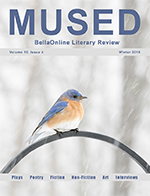Lace Online
Georgia Seitz
Does an old-fashioned art form such as lace making have a place in the electronic age?
Lace is a hole surrounded by thread, but the play of light reflected by the turning threads is a source of fascination, beauty and inspiration. A great variety of openwork fabrics can be formed by twisting, crossing, plaiting, looping, knitting or knotting threads by hands plying with needle, hook, bobbin or shuttle.
Through the centuries simple tools have created intricately beautiful pieces of bobbin lace, knitted lace, crocheted lace, macramé lace and tatted lace. Of all these types of lace, tatted lace may be the oldest.
In the dawn of time, prehistoric man learned to fashion nets to catch fish. As he refined his technique and invented the use of a shuttle to carry the strands of his net forward, he may well have invented "lace" at the same time. The knot used still today to form fish netting is called in macramé a lark´s head knot and in tatting it is known now as the double stitch.
Ancient Egyptians used such knots to create fringes on their clothing which much resemble tatted lace rings. The Chinese who developed knotting to a delicate art over many centuries may indeed have influenced the development of tatting as well. As trade grew between the countries of Europe, the Middle East and the Far East, the technique of knotting spread, too. Although the early historians and translators did not differentiate between embroidery, bobbin lace, knotting, netting, needlelace or tatting, later laces began to have distinctive names.
As for tatting, in the Middle East, it was called "makouk" referring to the tatting shuttle. In Italy it became known as "occhi" because the rings resembled eyes. The Germans called the shuttle a little boat (Schiffchen) because of its shape and the tatting was known as "Schiffchenarbeit." The French admired tatted lace but felt the work was frivolous, hence their name "frivolité." The Finns term "sukkulapitsi" meaning shuttle lace is most descriptive. Many believe the English term "tatting" is derived from the word tatters. Early pieces of tatting were made unjoined and then sewn together to form a pattern when finished, so it might well have had a tattered look to it.
Even though the many picots of tatting give it a fragile look, the lace produced is very strong and wears well. And whatever it is called, tatting is an art which has survived the ages. Advancements in tatting came slowly. The mid-19th century saw Mademoiselle Eleonore Riego de la Branchardiere developing the method of joining pieces of tatting through the picots. Mademoiselle Therese de Dillmont´s Encyclopedia of Needlework refined the techniques and spread the use of multiple shuttles and colors and the Josephine knot. Mrs. Beeton´s Book of Needlework acknowledges a certain Mrs. Mee for adding the use of a ball thread to that of the shuttle thread. After the turn of the century, Lady Katharin Hoare´s book The Art of Tatting which featured the tatting of Queen Marie of Romania inspired many to pick up their shuttles again and start tatting. Tatting quite probably crossed to the New World with the Pilgrims.
This gentle art of lacemaking continues to be passed to each succeeding generation. Fading in and out of the public view as fashions evolve and become passé, tatting is rediscovered at least once every decade. An inexpensive craft requiring only shuttle, thread and patience, tatting is also a surprisingly good method of stress management. Watching the shuttle fly and concentrating on forming the threads into intricate patterns causes the minor frustrations and inconveniences of the day to fade from mind and refreshes the spirit. It also helps us to keep in touch with our past and gives the next generation that touch of elegance which is easily forgotten in this "hurry-up" world so accustomed to instant gratification. Tatting is a delight for the mind, the eye and the hand.
But does it have a place in today´s electronic world? Yes! There are many computer programs now available for lacemakers to use to diagram the work. Such a project used to take weeks but is now done in minutes.
Fuzzy and grainy vintage photos of lace are now replaced by detailed clear scans which make it easy to follow the line of double stitches. And color shows the many possibilities of colored thread and beads, too.
The days of privately publishing a few patterns shared among family and friends is replaced by photo albums online and newsletters and groups who freely share their patterns with everyone online. New methods and designs travel the world around in merely seconds making lace, in particular tatting, available to everyone!
So, again, yes! Lacemaking has a place in the electronic age!

